Serviços Personalizados
Journal
Artigo
Indicadores
-
 Citado por SciELO
Citado por SciELO -
 Acessos
Acessos
Links relacionados
-
 Similares em
SciELO
Similares em
SciELO
Compartilhar
Tourism & Management Studies
versão impressa ISSN 2182-8458
TMStudies vol.11 no.1 Faro jan. 2015
TOURISM – RESEARCH PAPERS
Cross-cultural comparison of the relationships among perceived risk online, perceived usability and satisfaction during browsing of a tourist website
Comparación cross-cultural de las relaciones entre el riesgo percibido online, la usabilidad percibida y la satisfacción hacia un destino turístico
Juan Miguel Alcántara-Pilar1; Salvador Del Barrio-García2; Esmeralda Crespo-Almendros3
1University of
Granada, Department of Marketing and Market Research, Faculty of Education, Economy and
Technology, c\Cortadura del Valle, s.n. 51001 - Ceuta, Spain, jmap@ugr.es
2University of
Granada, Department of Marketing and Market Research, Faculty of Economics and Business,
18071-Granada, Spain, dbarrio@ugr.es
3University of
Granada, Department of Marketing and Market Research, Faculty of Economics and Business,
18071-Granada, Spain, ecrespo@ugr.es
ABSTRACT
The purpose of this paper is to empirically analyze the influence of culture on the relationships among perceived risk, perceived usability and satisfaction online, in two cultures: Spain (high uncertainty avoidance and low individualism) and the United Kingdom (low uncertainty avoidance and high individualism). The sample comprised 314 Internet users, 119 of whom were Spanish and 195 British. They were asked to browse the experimental website of a fictitious tourist destination. The findings indicated that there are significant differences between the direct influence of perceived risk on perceived usability and also the indirect relationship between perceived risk and satisfaction online during browsing of the tourist website, and that these differences are moderated by the uncertainty avoidance dimension.
Keywords: Perceived risk online, perceived usability, satisfaction online, uncertainty avoidance, individualism.
RESUMEN
El propósito de este trabajo es analizar empíricamente la influencia de la cultura sobre la relación entre el riesgo percibido, la usabilidad y la satisfacción percibida online, entre dos culturas: España (Alto control de incertidumbre y bajo el individualismo) y del Reino Unido (Bajo control de incertidumbre y alto individualismo). La muestra estaba compuesta por 314 usuarios de Internet. De ellos, 119 eran españoles y 195 británicos. Se les pidió que navegar por un sitio web de un destino turístico ficticio. Los resultados indicaron que existen diferencias significativas entre la influencia directa del riesgo percibido en la usabilidad percibida y también la relación indirecta entre el riesgo percibido y la satisfacción en línea durante la navegación por la página web de turismo, y que estas diferencias estaban moderadas por la dimensión control de incertidumbre
Palabras-clave: Riesgo percibido, usabilidad percibida, satisfacción online, evasión de incertidumbre, individualismo.
1. Introduction
The Internet can be considered one of the media that has made among the most significant contributions to the globalization of markets (Constantinides, Lorenzo-Romero & Gómez, 2010), thanks to its capacity to give users the opportunity to interact with firms located anywhere in the world. This therefore has major implications for those firms using this medium to commercialize their products (Gémar, 2014). Within this globalized context, it is vital to take into account the cultural differences that exist in different markets (Rey, Medina & Rufín, 2013). Several authors highlight that national cultural values are of vital importance in explaining users behavior toward information and communications technologies (ICTs) (Karahanna, Evaristo & Srite, 2005; Srite & Karahanna, 2006) and, therefore, toward the Internet. Cultural differences between countries may explain why certain strategies applied by firms on an international scale work successfully in some countries but not in others (Jin, Park & Kim, 2008).
Furthermore, when designing their online marketing strategies, firms need to take into account a number of key elements. On the one hand, the risk perceived by users during browsing is critical for the formation of their initial perceptions of a given website (Beldad, Jong & Steehouder, 2010). On the other hand, perceived website usability has been found to be an important antecedent in satisfaction-formation among users (Flavián, Guinalíu & Gurrea, 2006). In the case of tourism firms, Rey et al. (2013) highlighted the need to adapt marketing strategies to the cultural values of the target public, thanks to the moderating effect of these values on the process of satisfaction-formation.
To date there have been very few works that examine the moderating effect of national culture on the variables perceived risk, perceived usability and satisfaction during the online browsing process; and fewer still in the tourism sphere. The rationale for selecting the tourism sector as the focus for the research was that the World Tourism Organization (WTO) has declared that the key to firms success in using the Internet to provide tourism information is to swiftly identify consumers needs and establish direct contact with tourists. Furthermore, the WTO has asserted that websites should offer tourists information that is comprehensive, personalized and up-to-date (Vich-I-Martorell, 2003). The Internet is one of the main sources of information used by tourists when making travel plans (Buhalis & Law, 2008; Wu, Wei & Chen, 2008). In 2012 alone, some 65% of all tourists entering Spain – one of the leading tourist destinations world-wide – had used the Internet as an information source for the purposes of their visit (IET, 2013). This behavior can be considered habitual and common throughout the great majority of countries and cultures, hence the decision to use this sector for the purposes of the present study.
The main aim of the present research is therefore to analyze how the national culture of Internet users (Spanish vs. British) – measured in terms of individualism and uncertainty avoidance – affects the antecedent relationships behind the satisfaction experienced by users when browsing a tourist destination website.
2. Theoretical framework
Cross-cultural research in the area of business management has undergone significant growth in recent years, thanks largely to the increasingly global nature of markets. Authors such as Gefen and Heart (2006) have demonstrated that an individuals culture affects their behavior as a consumer. Elsewhere, De Mooij and Hofstede (2002) reject the posture of Levitt (1983), who asserted that technological advances would lead to greater homogeneity of consumer behavior and standardized product preferences. Academic research has shown that although markets are shifting toward globalization, user behavior in relation to products or services continues to differ depending on the cultural values of their country of origin.
Cross-cultural studies on tourism have also witnessed growth in recent decades (Dimanche, 1994). Most cross-cultural e-tourism enterprises are having to deal with significant changes in the sector that have arisen as a result of the development of ICTs. Key developments include the need to sustain an active presence in social networks or adapt their websites to the demands of the market by including, for example, search engines and online booking facilities, or making their sites suitable for Smartphone use. These changes have transformed the tourism sector thanks to the rapid internationalization process it has undergone (Buhalis and Law, 2008).
Since the 1980s there has been an on-going debate regarding the most suitable approach to the study and comparison of cultures, the principal perspectives being those of: Hofstede (2001); Hall (1976); Schwartz (1994); and House, Hanges, Javidan, Dorfman & Gupta (2004) with their GLOBE model (Global Leadership and Organizational Behavior Effectiveness). According to Engelen and Brettel (2011), of these approaches, that which has received the greatest attention throughout the scientific literature on business management and marketing is that of Hofstede (2001), his work being considered a benchmark in the field of cross-cultural comparison between different countries (see Table 1).
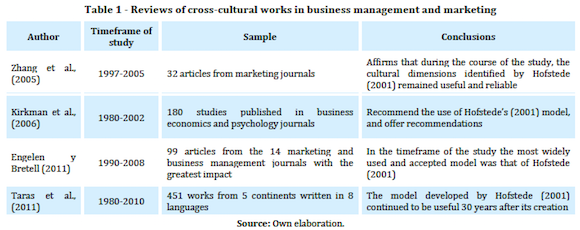
The work of Hofstede (2001) provides a strong empirical base and a guide map to his cultural dimensions (Kolman, Noorderhaven, Hofstede & Dienes, 2003). More specifically, this author classified cultures into five dimensions: power distance (PD), uncertainty avoidance (UA), individualism (IND), masculinity (MAS) and long-term orientation (LTO). In the tourism sector Hofstedes (2001) approach has also been widely accepted and implemented by several authors (Funk & Bruun, 2007; Hudson, Hinch, Walker & Simpson, 2010; Hsu, Woodside & Marshall, 2013; Liu, Chakpitak, Yodmongkol & Cang, 2014; Litvin, Crotts & Hefner, 2004; Reisinger, 2008). Furthermore, Hsu et al. (2013) demonstrated the validity of Hofstedes model when measuring cultural differences in the tourism sector, and recommended treating cultural values together as a whole when studying the influence of culture on consumer behavior, rather than measuring the values individually.
The literature review for the present study demonstrates that the UA dimension is one of the most widely-used in online consumer behavior studies, not only thanks to its ease of interpretation in the online context but also because the existing literature demonstrates that perceived risk is among the most highly determinant elements of consumer purchasing behavior (Cheung, Chan & Limayen, 2005). Similarly, a number of different works have found that UA has a direct and positive relationship with perceived risk (Green & Pearson, 2014; Lee, Joshi & Bae, 2009) and has a significant effect on perceived risk among e-commerce loyalty and purchase intentions (Frost, Goode & Hart, 2010), cross-cultural tourist behavior (Litvin et al., 2004; Money & Crotts, 2003) and cross-cultural analysis of the effect of language on perceived risk toward a tourist destination (Alcántara-Pilar & Del Barrio-García, 2014; Alcántara-Pilar, Del Barrio-García & Porcu, 2013).
Meanwhile, Green and Pearson (2014) demonstrate that there is a negative relationship between perceived risk and website usability, the latter being measured in terms of user satisfaction with the design – in other words, their overall perception of how easy the website is to use. More specifically in the tourism field, Sabiote, Frías and Castañeda (2012a) demonstrated that the UA dimension moderated the negative relationship between perceived risk and perceived hotel quality, the latter referring to the overall value that users assigned to the hotel. This idea of overall quality or value, when extended to a website, would relate to the concept of usability or the extent to which a specific site can be used to achieve specific goals while achieving effectiveness, efficiency, and satisfaction in a particular environment (ISO, 1998). The usability perceived by the user is simply the value they attach to the website. It is thus to be assumed that there is a negative relationship between perceived risk and perceived usability which, according to the literature, is moderated by the UA cultural dimension. Therefore it is proposed that:
H1: There is a negative relationship between perceived risk and perceived usability, which will be greater among users from cultures with a high level of UA (Spanish sample), compared to users from cultures with a low level of UA (British sample).
Elsewhere, Flavián et al. (2006) and Casaló, Flavián and Guinalíu (2008) demonstrated the existence of a direct and positive relationship between perceived usability and user satisfaction during the browsing process. In the tourism field, Sabiote, Frías and Castañeda (2012b) identified the existence of a direct and positive relationship between perceived effectiveness (a dimension of perceived usability) and online satisfaction, moderated by the level of individualism (IND) presented by British vs. Spanish users. One possible explanation for this finding may be that demand for high levels of effectiveness and efficiency is greater among users from individualist cultures than among those from collectivist cultures. Users from individualist cultures tend to be more competitive and independent, and place greater importance on the utilitarian values of products (in the case of the present study, a tourism website). The more efficient they perceive it to be, the greater their satisfaction.
In view of these arguments, the following hypothesis is proposed:
H2: There is a positive relationship between perceived usability and satisfaction online which will be lesser among users from cultures with a low level of IND (Spanish sample), compared to users from cultures with high level of IND (British sample).
Hypotheses H1 and H2 can be summarized in the theoretical model presented in Figure 1.
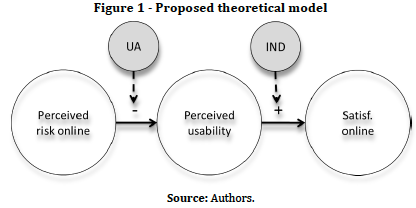
3. Methodology
3.1 Independent variable
A between-subjects experimental design was deemed to fit best with the research objectives using national culture as an independent variable with two levels: Spanish users vs. British users. The choice of the countries for the experiment was based on Spain and UK demonstrating major differences in the uncertainty avoidance dimension (Spain, 86 vs. UK, 35) and individualism (Spain, 51 vs. UK, 89) (Hofstede, 2001).
3.2 Experimental website design and sample selection
A website for a fictitious tourist destination called Buyuada was used as the framework for the experiment. A fictitious location was devised with a view to avoiding a scenario in which subjects previous awareness of, or attitudes towards, the destination might affect the results (Dahlén, Friberg & Trevino, 2009).
The experiment itself required a professional website to be purpose-built, with its own domain name, providing information on the fictitious tourist destination (www.buyuada.org). The fact that the site had its own domain meant that natural browsing conditions could be simulated for subjects. Two versions of the site were created – one written in Spanish and the other in English (see Figure 2 and Figure 3). The subjects were assigned their respective versions according to their mother tongue (that is, in Spanish for the Spanish sample and in English for the British).
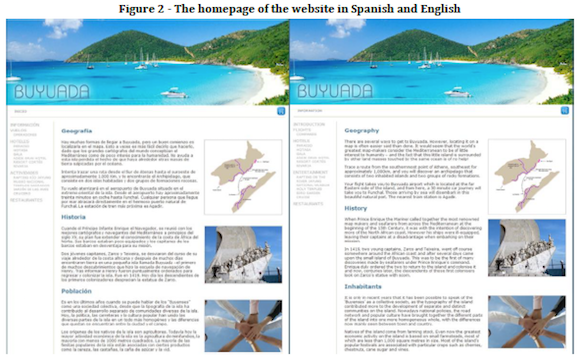
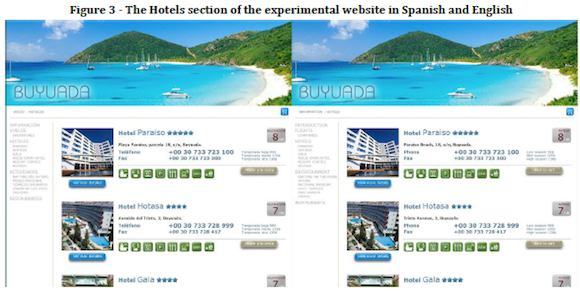
The subjects were selected by an external company commissioned to establish an online survey panel for the experiment. The company made email contact with each panel member, following the gender and age quotas that had been pre-established. The subjects were sent a link to the appropriate version of the website, together with instructions. The users had to browse through the website and put together their own tourism package based on an outward flight, a return flight, hotel accommodation, and a restaurant, from the multiple options on offer. Once browsing was complete, subjects were redirected to a questionnaire. The planned sample size was 350 individuals – 175 for each of the two treatments: T1 (Spanish users) and T2 (British users). The final sample comprised 314 Internet users, of whom 38% were Spanish (119) and 68% British (195).
As regards educational level, the sample was divided into three sub-groups: primary-education qualifications, secondary-education qualifications, and university-level qualifications. The highest percentage was for Higher Education (56.01% of the sample), followed by secondary-education qualifications (40.73%) and no qualifications (3.26%). In the case of both Spain and the UK, over 95% of users had secondary-level qualifications or a university education (AIMC, 2010; ONS, 2010). These percentages were similar for both cultures (see Table 2).
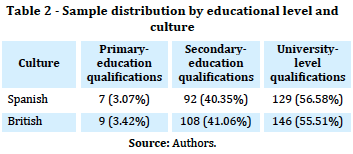
To ensure that users came from Spain and the UK, Google Analytics was used during the data collection (see Figure 4). To minimize the risk of contamination we decided to apply a strict criterion for participation, in that any users who accessed the experimental website from outside UK or Spain would not be included in the study.
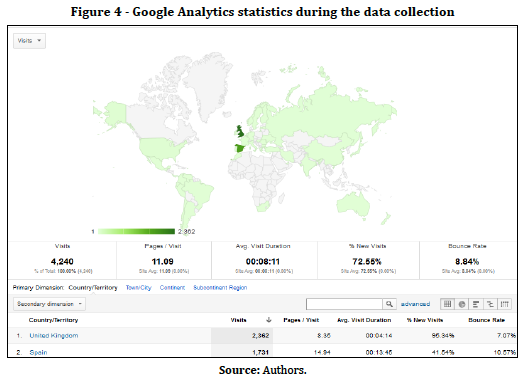
3.3 Measures
With regard to measures, 7-point Likert scales were used, on which 1 equaled totally disagree and 7 equaled totally agree. The online risk perceived by the individual when processing the information on the experimental website was measured using the scale proposed by Wakefield and Whitten (2006). Perceived usability of the site was measured from the users perspective by applying the Website Analysis and Measurement Inventory (WAMMI) scale proposed by Kirakowski, Claridge and Whitehand (1998) and adapted by Flavián et al. (2006). To measure satisfaction online during the browsing we used the Szymansky and Hise (2000) scale (see Annex 1).
As well as measuring the cultural dimensions during the experiment using the VSM94 scale developed by Hofstede (2001), the study also measured variables of a socio-demographic nature such as gender and age.
4. Results
4.1 Standardization of cross-cultural studies
When working with samples from different cultures it is important to address any issues arising from equivalence and deviation. The method proposed by Cheung and Rensvold (2000) was applied, using factorial invariance analysis, examining whether members of both cultures gave equal weight to the different indicators used to measure the theoretical constructs. The results obtained revealed the existence of cultural response bias. From the most widely-used models proposed in the literature, we decided on the method of standardization among cultures which involves subtracting all values of each culture from the mean of the culture in question and then dividing it by the standard deviation (Fischer, 2004).
4.2 Manipulation check
Before testing the hypotheses the UA and IND values for the respective samples were tested to analyze whether Hofstedes original values were being maintained. The cultural scores obtained for the Spanish sample (T1) were 88.37 (IND) and 80.62 (UA). The British sample (T2) obtained 89 (IND) and 35 (UA) (see Table 3). The works of García et al. (2008, 2012) also found high values in the individualism dimension of a sample comprising Spaniards. Specifically, in their latest work the authors analyzed the possible cultural differences within the Iberian Peninsula, obtaining some surprising results for the Spanish sample, which registered values of 84.7 for individualism.
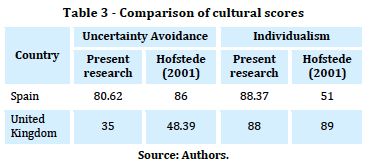
The values obtained in the present study indicate that cultural differences found in Hofstedes seminal work were maintained in the samples for the UA dimension, but this was not the case in the IND dimension, the two countries presenting similar values.
4.3 Testing the hypotheses
Testing the proposed hypotheses required us to estimate the proposed causal model by means of a multigroup SEM analysis (Spanish vs. British). To this end, we used the LISREL 8.8 program. The measurement model was found to be satisfactory, with all the items presenting individual reliability (R2) above 0.50, and composite reliability and average variance extracted values for the three scales being above recommended values (0.7 and 0.50, respectively). The overall goodness-of-fit indices revealed that the estimated multigroup model was quite acceptable (see Table 4) (Hair & Anderson, 2010).
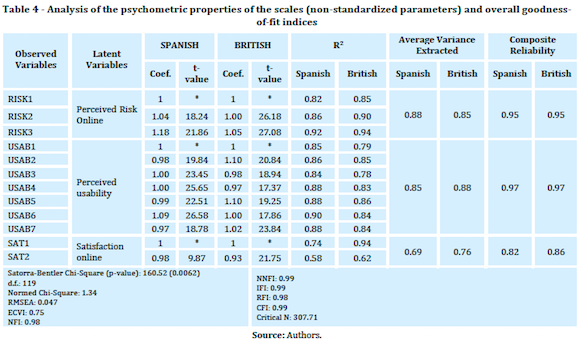
Likewise, the discriminant validity of the three constructs in each group was tested following the procedure proposed by Fornell and Larcker (1981), according to which the square root of the extracted variances must be greater than the correlations between constructs (see Table 5).

Before testing the cultural hypotheses (H1 and H2), each relationship in each culture was examined. As Table 6 indicates, all relationships were significant in both the Spanish and the British sample. The effect of perceived risk on perceived usability was negative and the effect of perceived usability on satisfaction online was positive, both in the expected direction. In terms of cultural differences, one of the two relations was significantly different between Spanish and British users (p<0.01) (see Table 6 and Figure 5). Specifically, H1 proposed that the negative effect of perceived risk on perceived usability would be greater for the sample with high UA (Spanish sample) that for the sample with low UA (British sample). Analysis showed that the coefficients were negative in the expected direction (β1_Spanish:-0.61; β1_British:-0.22), therefore H1 was accepted.

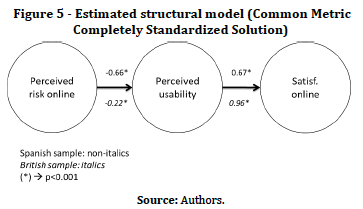
With regard to the relationship between perceived usability and satisfaction online, H2 proposed that this would be positive and weaker for the sample with low IND (Spanish) than for the sample with high IND (British). The coefficients were in the expected direction (β2_Spanish:0.67; β2_British:0.95) but the differences were quasi-significant (p<0.10). Hence, H2 was also partially confirmed. These results may have been influenced by the fact that the dimension that moderates this relationship – namely IND – registered very similar values in both groups, in contrast to the differences originally identified in the work of Hofstede (2001).
The negative indirect effect (IEF) of perceived risk on satisfaction online was greater among the Spanish sample (IEFSpanish= -0.44) than for the British (IEFBritish= -0.17). These findings show the importance of perceived risk online in terms of its impact on user behavior during browsing and purchasing via the Internet. The findings also highlight how this effect differs depending on the culture to which the user belongs.
5. Conclusions
This empirical cross-cultural comparison between Spanish and British users reveals the moderating effect of UA and IND on the relationships analyzed, including the indirect influence of perceived risk on satisfaction online. This moderating effect is a key moderator of user behavior on the Internet.
The present work offers a validated model of online satisfaction in the context of browsing a tourist destination website. The model includes a variable of a cognitive nature, namely perceived risk, which is a key element that shapes the initial image a user forms of a website (Beldad et al., 2010). The model also includes two elements of an affective nature: perceived usability and online satisfaction. With regard to the former relationship, the study finds that the level of risk a user perceives when browsing a given site has a negative effect on their perception of the sites usability, and that this relationship is moderated by the extent of UA presented by their culture of origin (the coefficient between perceived risk and perceived usability being more negative in the Spanish sample). Similarly, the effect of risk on user online satisfaction during browsing is negative and much greater in the case of the Spanish sample than in the British sample. It was also found that IND moderates – albeit only presenting a quasi-significant effect – the relationship between perceived usability of the website and the subjects satisfaction during browsing. This may be explained by the fact that the IND scores for both samples were very similar.
5.1 Contributions and implications
One important contribution of the present work is that we did not simply assume that Spanish and British users have different IND and UA values, as per the seminal work of Hofstede (2001). Rather, we endeavored to examine via the sample to what extent those original cultural scores remain true today. By contrast, other studies have used the original values obtained by Hofstede (2001) as their cultural reference framework, without confirming their validity in the samples they use (Karahanna et al., 2013; Lim, Yeow & Yuen, 2010); indeed this is one of key criticisms typically leveled at cross-cultural studies. In the present work, however, before users where submitted to the experimental treatment they were given a questionnaire designed to capture their cultural values, in line with the VSM94 scale proposed by Hofstede (2001). This step made it possible to detect similarities between the British and Spanish in the IND dimension, contrasting with the original values obtained by Hofstede which were markedly different. This enabled us to test that in the sample of Internet users that we selected there were no major differences in the IND dimension. These results demonstrate, in cross-cultural studies, the importance of testing the cultural values present in the samples used rather than simply relying on the original scores ascertained by Hofstede (2001), so as to avoid erroneous conclusions being drawn from the data analysis.
A further contribution of the present work is the fact that it was based on an experiment using a website promoting a fictitious tourist destination presented in two versions (depending on the mother tongue of the sample user group) and designed to encourage users to browse freely while putting together a tourism package. This approach sought to create a task in which information-processing during the experiment would be as similar as possible to a real-life browsing scenario and contracting process for tourists. By contrast, other works in the cross-cultural sphere have focused only on inviting subjects to complete a questionnaire, without previously having undertaken a complete and detailed browsing process (Li & Huang, 2009).
A major implication of our empirical study is that it confirms the importance of perceived risk in establishing customer satisfaction online. Its importance is even more critical in online retailing as customers receive fewer signals over the Internet than they do from traditional physical stores. In this regard, managers need to pay particular attention to providing secure navigation and converting this security into a source of sustainable competitive advantage.
In view of the aforementioned conclusions, it is important to note that many firms mistakenly believe that adapting the website to the user simply involves translating the content, when the academic literature has shown that this is insufficient (Okazaki, 2004). An in-depth study of the differentiating elements of cultures, and its application to the website, would enable firms to achieve the so-called come & stop effect (Coyle & Thorson, 2001) whereby consumers enter the website and stop there, satisfied that their search is over. This is of particular interest for the tourism sector given that, in the majority of destinations, potential clients come from very different cultures. It is recommended that firms undertake marketing strategies that differentiate between cultural segments. For instance, when dealing with a segment of tourists characterized by a high UA index, the objective of the website should be to endeavor to reduce the level of perceived risk. A good example of this approach is the strategy employed by firms such as booking.com or tripadvisor.com, which offer a simple system that facilitates the process by which users can find information on the reliability of the service in question (hotels, flights, vacation rentals, etc.). This is achieved via customer evaluations, number of comments, or the classifications offered by intermediaries such as travelers´ choice (in the case of tripadvisor.com) or by means of the most booked properties icon for the previous year. Such elements provide a sense of security for the user which, in turn, translates into lower perceived risk. Furthermore, websites should include hallmarks of online security that are internationally recognized, such as paypal.com, which provide a level of confidence when carrying out transactions.
5.2 Limitations and future research
The main limitation of the present study is the fact that the sample we analyzed showed similar values for the IND dimension (88.37 Spanish vs. 88 British), when in the seminal study undertaken by Hofstede (2001) Spain presented a much lower value in this particular dimension. There are many possible explanations for this change which could be explored in future studies. Firstly, there have been many technological changes in recent decades which may be affecting the IND dimension, as noted by some authors including McCoy, Galleta and King (2005). Second, the economic development witnessed in Spain may also be behind this shift. Indeed Hofstede, Hofstede and Minkov (2010: 133–134) affirm that the IND dimension is directly related to a countrys development. Bearing in mind that Hofstede (2001) took his baseline reference index for Spain in the early 1990s when the Spanish economy was undergoing a particularly difficult period, the striking change in this index, some 20 years later, may find its explanation here. A third possible reason for the shift in IND values may be that suggested by De Mooij (2011: 290), who proposed the existence of a direct and positive relationship between the IND dimension and Internet use. The sample used in the present study comprised expert Internet users, which therefore may have contributed to increasing the IND values.
Research into cross-cultural e-tourism currently deals with a wide range of topic areas (Kim, Chung & Lee, 2011). It could be said that this research area is in a developmental phase and that certain issues are only just starting to be investigated (Liu et al., 2014). The present work centers on an analysis of perceived risk and perceived usability as antecedents of satisfaction online, within the e-tourism sphere. Future studies could build on this approach and integrate other areas of interest to the sector, such as social media. As Limberger, Anjos, Meira and Anjos (2014) affirm, the tourism sector is extremely vulnerable amidst the changes arising in the use of the Internet. Another interesting approach would be to analyze satisfaction online as an antecedent of WOM, in line with the recommendations of Abdalla, Ribas and Vieira (2014), or as an antecedent of loyalty in the tourism sector, as noted by Batista, Couto, Botelho and Faias (2014).
References
Abdalla, M.M., Ribas, J.R., & Vieira, P.R. (2014). The antecedents of word of mouth intentions about a Brazilian tourist destination. Tourism & Management Studies, 10(1), 104-111. [ Links ]
AIMC (2010): 12ª encuesta a usuarios de Internet. Navegantes en la Red. Retrieved March, 10, 2014 from http://www.aimc.es/-AIMC-.html. [ Links ]
Alcántara-Pilar, J. M., & del Barrio-García, S. (2014). Perceived risk in e-commerce and the development of loyalty: the moderating effect of website design, the cultural framework of language, and the users flow state. In F. Liébana-Cabanillas, F. Muñoz-Leiva, J. Sánchez-Fernández, & M. Martínez-Fiestas (Eds.), Electronic Payment Systems for Competitive Advantage in E-Commerce (pp. 93-114). Hershey, PA: IGI Global. Doi:10.4018/978-1-4666-5190-6.ch006.
Alcántara-Pilar, J.M., Del Barrio-García, S., & Porcu, L. (2013). A cross-cultural analysis of the effect of language on perceived risk online. Computers in Human Behavior, 29(3), 596-603. [ Links ]
Batista, M.G., Couto, J.P., Botelho, D. & Faias, C. (2014). Tourist satisfaction and loyalty in the hotel business: An application to the island of Sao Miguel, Azores. Tourism & Management Studies, 19(1), 16–23. [ Links ]
Beldad, A., Jong, M., & Steehouder, M. (2010). How shall I trust the faceless and the intangible? A literature review on the antecedents of online trust. Computers in Human Behavior, 26(5), 857-869. [ Links ]
Buhalis, D. & Law, R. (2008). Progress in information technology and tourism management: 20 years on and 10 years after the Internet—The state of eTourism research. Tourism management, 29(4), 609–623. [ Links ]
Casaló, L. V., Flavián, C., & Guinalíu, M. (2008). The role of satisfaction and website usability in developing customer loyalty and positive word-of-mouth in the e-banking services. International Journal of Bank Marketing, 26(6), 399-417. [ Links ]
Cheung, G.W., & Rensvold, R.B. (2000). Assessing extreme and acquiescence response sets in cross-cultural research using structural equation -modeling. Journal of Cross-Cultural Psychology, 31(2), 187-212. [ Links ]
Cheung, C., Chan, G. & Limayen, M. (2005). A critical review of online consumer behaviour: empirical research. Journal of Electronic Commerce in Organization, 3(4), 1-19. [ Links ]
Constantinides, E., Lorenzo-Romero, C. & Gomez, M.A. (2010). Effects of web experience on consumer choice: a multicultural approach. Internet Research, 20(2), 188-209. [ Links ]
Coyle, J. R. & Thorson, E. (2001). The effects of progressive levels of interactivity and vividness in web marketing sites. Journal of advertising, 30(3), 65-77. [ Links ]
Dahlén, M., Friberg, L., & Nilsson, E. (2009). Long live creative media choice. Journal of Advertising, 38(2), 121–129. [ Links ]
De Mooij, M. (2011). Consumer behavior and culture: Consequences for global marketing and advertising. 2nd ed. Thousand Oaks, CA: Sage Publications.
De Mooij, M., & Hofstede, G. (2002). Convergence and divergence in consumer behavior: implications for international retailing. Journal of retailing, 78(1), 61-69. [ Links ]
Dimanche, F. (1994). Cross-cultural tourism marketing research. Journal of International Consumer Marketing, 6(3-4), 123-160. [ Links ]
Engelen, A., & Brettel, M. (2011). Assessing cross-cultural marketing theory and research. Journal of Business Research, 64, 516-523. [ Links ]
Flavián, C., Guinalíu, M., & Gurrea, R. (2006). The role played by perceived usability, satisfaction and consumer trust on website loyalty. Information & Management, 43(1), 1-14. [ Links ]
Fischer, R. (2004). Standardization to account for cross cultural response bias. A classification of score adjustment procedures. Journal of Cross-cultural Psychology, 35(3), 263-282. [ Links ]
Fornell, C. & Larcker, D. (1981). Evaluating Structural Equation Models with Unobservable Variables and Measurement Error. Journal of Marketing Research, 18, 39-50. [ Links ]
Frost, D., Goode, S. & Hart, D. (2010). Individualist and collectivist factors affecting online repurchase intentions. Internet Research, 20(1), 6-28. [ Links ]
Funk, D.C. & Wu, A. (2007). The role of socio-psychological and culture-education motives in marketing international sport tourism: a cross-cultural perspective. Tourism Management, 28(3), 806-819. [ Links ]
García Del Junco, J., Dutschke, G., & Petrucci, M. (2008). The Hofstede model in the study of the impact of Sevilla Expo 92. Revista de Turismo y Patrimonio Cultural, 6(1), 27-36. [ Links ]
García del Junco, J., Dutschke, G., Espasandin Bustelo, F. & Dutschke, M. (2012). Análisis cross cultural, desarrollo humano y social. La situación de España y Portugal. [ Links ] Paper presented at Jornadas Luso-Españolas 2012, University of Tras-os-Montes and Alto Douro, Vila Real, Portugal.
Gefen, D., & Heart, T. H. (2006). On the need to include national culture as a central issue in e-commerce trust beliefs. Journal of Global Information Management, 14(4), 1-30. [ Links ]
Gémar, G. (2014). Influence of cultural distance on the internationalization of Spanish hotel companies. Tourism & Management Studies, 10(1), 31-36. [ Links ]
Green, D.T., & Pearson, J.M. (2014). Integrating website usability with the electronic commerce acceptance model. Behaviour and Information Technology, 30(2), 181-199. [ Links ]
Hair, J.F. & Anderson, R.E., (2010). Multivariate data analysis. New Jersey: Prentice Hall Higher Education. [ Links ]
Hall, E.T. (1976). Beyond culture. New York: Double Day. [ Links ]
Hofstede, G. (2001). Cultures consequences. Comparing values, behaviors, institutions and organizations across nations (2nd ed.). Thousand Oaks, CA: Sage Publications.
Hofstede, G., Hofstede, G.J. & Minkov, M. (2010), Cultures and organizations: Software of the mind (3rd ed.), New York, NY: McGraw-Hill.
House, R.J., Hanges, P.J., Javidan, M., Dorfman, P.W. & Gupta, V. (2004). Culture leadership and organizations: The GLOBE Study of 62 Societies. Thousand Oaks, CA: Sage Publications.
Hsu, S.Y., Woodside, A.G. & Marshall, R. (2013). Critical tests of multiple theories of cultures´ consequences. Comparing the usefulness of models by Hofstede, Inglehart and Baker, Schwartz, Steenkamp, as well as GDP and Distance for explaining overseas tourism behavior. Journal of Travel Research, 52(6), 679-704. [ Links ]
Hudson, S., Hinch, T., Walker, G. & Simpson, B. (2010). Constraints to sport tourism: a cross-cultural analysis. Journal of Sport & Tourism, 15(1), 71-88. [ Links ]
IET (2013): Movimientos turísticos en fronteras (FRONTUR-EGATUR). Madrid: Ministerio de Industria, Turismo y Comercio. [ Links ]
ISO (1998). ISO 9241: Ergonomic requirements for office work with visual display terminals. Part 11: Guidance on usability, International Organization for Standardization. [ Links ]
Jin, B., Park, J. Y., & Kim, J. (2008). Cross-cultural examination of the relationships among firm reputation, e-satisfaction, e-trust, and e-loyalty. International Marketing Review, 25(3), 324-337. [ Links ]
Karahanna, E., Evaristo, J.R, & Srite, M. (2005). Levels of culture and individual behavior: an integrative perspective. Journal of Global Information management, 13(2), 1-20. [ Links ]
Karahanna, E., Williams, C.K., Polites, G.L., Liu, B., & Seligman, L. (2013). Uncertainty avoidance and consumer perceptions of global e-commerce sites: a multi-level model. Drake management review, 3(1), 12-47. [ Links ]
Kim, M., Chung, N., & Lee, C. (2011). The effect of perceived trust on electronic commerce: Shopping online for tourism products and services in South Korea. Tourism Management, 32 (2), 256-265. doi: 10.1016/j.tourman.2010.01.011 [ Links ]
Kirakowski. J., Claridge. N., & Whitehand. R. (1998). Human centered measures of success in web site design. [ Links ] Paper presented at the Human Factors and the Web Workshop. Basking Ridge. NJ.
Kolman, L., Noorderhaven, N. G., Hofstede, G., & Dienes, E. (2003). Cross-cultural differences in Central Europe. Journal of Managerial Psychology, 18(1), 76-88. [ Links ]
Lee, K., Joshi, K. & Bae, M. (2009). A Cross-national comparison of determinants of customer satisfaction with online stores. Journal of Global Information Technology Management, 12(4), 25-51. [ Links ]
Levitt, T. (1983). The Globalization of markets. Harvard Business Review, 61(3), 91-102. [ Links ]
Li, Y. & Huang, J. (2009). Applying theory of perceived risk and technology acceptance model in the online shopping channel. World Academy of Science, Engineering and Technology, 53, 919-925. [ Links ]
Lim, N., Yeow, P.H.P. & Yuen, Y.Y. (2010). An online banking security framework and cross-cultural comparison. Journal of Global Technology Management, 13 (3), 39-62. [ Links ]
Limberger, P.F., Anjos, F.A., Meiria, J.V.S. & Anjos, S.J.G. (2014). Satisfaction in hospitality on TripAdvisor.com: an analysis of the correlation between evaluation criteria and overall satisfaction. Tourism & Management Studies, 10(1), 59-65 [ Links ]
Litvin, S.W., Crotts, J.C. & Hefner, F.L. (2004). Cross-cultural tourist behavior: a replication and extension involving Hofstedes uncertainty avoidance dimension. International Journal of Tourism Research, 6(1), 29-37. [ Links ]
Liu, X., Chakpitak, N., Yodmongkol, P. & Cang, S. (2014). Analysis of intellectual capital disclosure in cross-cultural e-tourism enterprises. Journal of Intellectual Capital, 15(2), 249-263. [ Links ]
McCoy, S., Galleta, D.F. & King, W.R. (2005). Integrating national culture into IS research: the need for current individual level measures. Communications of the Association for Information Systems, 15(12), 210- 225 [ Links ]
Money, B.R. & Crotts, J.C. (2003). The effect of uncertainty avoidance on information search, planning and purchases of international travel vacations. Tourism Administration, 1(1), 191-202. [ Links ]
ONS (2010). UK National Statistics. Retrieved March 13, 2014 from http://www.statistics.gov.uk/hub/index.html. [ Links ]
Okazaki, S. (2004). Do multinationals standardise or localise? The cross-cultural dimensionality of product-based Web sites. Internet Research, 14(1), 81-94. [ Links ]
Reisinger, Y. (2008). 16 Cross-cultural differences in tourist behavior. Handbook of tourist behavior: theory & practice. New York-London: Routledge. [ Links ]
Rey Moreno, M., Medina Molina, C. & Rufín Moreno, R. (2013). Satisfacción, lealtad y colectivismo en destinos culturales. Tourism & Management Studies, 9(2), 44-49. [ Links ]
Sabiote, C. M., Frías, D. M., & Castañeda, J. A. (2012a). The moderating effect of uncertainty-avoidance on overall perceived value of a service purchased online. Internet Research, 22(2), 180-198. [ Links ]
Sabiote, C. M., Frías, D. M., & Castañeda, J. A. (2012b). E-service quality as antecedent to e-satisfaction: The moderating effect of culture. Online Information Review, 36(2), 157-174. [ Links ]
Schwartz, S.H. (1994). Are there universal aspects in the structure and contents of human values? Journal of Social Issues, 50, 19-45. [ Links ]
Srite, M. & Karahanna, E. (2006). The influence of national culture on the acceptance of information technologies: an empirical study. MIS Quarterly, 30(3), 679-704. [ Links ]
Szymansky, D. & Hise, R. (2000). E-satisfaction: an initial examination. Journal of Retailing, 76(3), 309-322. [ Links ]
Taras, V., Steel, P. & Kirkman, B.L. (2011). Improving national cultural indices using a longitudinal meta-analysis of Hofstedes dimensions. Journal of World Business, 47(3), 329–341. [ Links ]
Vich-I-Martorell. G.A. (2003). The internet and tourism principals in the Balearic Islands. Tourism and Hospitality Research, 5(1), 25–44. [ Links ]
Wakefield, R.L. & Whitten, D. (2006). Examining user perceptions of third-party organization credibility and trust in an e-retailer. Journal of Organizational and End User Computing, 8(2), 1-19. [ Links ]
Wu, S., Wei, P.L., & Chen, J.-H. (2008). Influential factors and relational structure of Internet banner advertising in the tourism industry. Tourism Management, 29(2), 221–236. [ Links ]
Zhang, J., Beatty, S.E., & Walsh, G. (2005). Cross-cultural services research: a review of the literature and future research directions. In L. Huff & S.M. Smith (eds), Proceeding of 10th Cross Cultural Research Conference, Puerto Rico, December 11-14. [ Links ]
Acknowledgement
The authors appreciate the financial help provided via a research project of group ADEMAR (University of Granada) under the auspices of the Andalusian Program for R&D, number P06-SEJ02170, and Research Program from the Faculty of Education, Economy and Technology of Ceuta.Article history:
Submitted: 03 June 2014
Accepted: 22 November 2014














